Know Your Tree
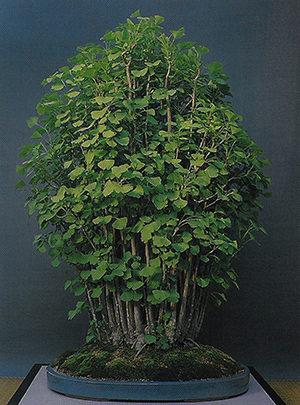
Gingko Biloba
by Lew Buller
Steve, the arborist I worked with, and I used to spend our spare time haunting nurseries, looking for plants that could be turned into bonsai. At one nursery going out of business, we found a couple of trees that had potential. Both had been ruthlessly broken down as they were considered not saleable and the owner did not want to move them. He gave them to us.
This Gingko was only about half the height of the tree it became with some tender loving care. The other was an Elaeagnus, that eventually became such a nice tree that it was featured on the cover of Number 4, Volume 38, Winter 2004 Journal of the American Bonsai Society. The Gingko appears on page 109 and the Elaeagnus on page 107 of Sunset Press’s January 2003 book, Sunset Bonsai. Not bad for two throw-away trees.
Also called the Maidenhair Tree (or Duck’s Foot tree), when young it is a comparatively smooth-barked, sparingly branched tree. As it ages, sometimes reaching 120 feet in height, the bark may become rougher. The leaves are 2-4 inches wide and nearly as long; in form, veining, and appearance they resemble the leaves of the maidenhair fern. The leaf also looks like a duck’s foot. John Rojas, Jr. on page 156 in his book Chula Vista’s Trees, refers to a Gingko in Sendai, Japan which is 97 feet tall, 27 feet in circumference, and estimated to be 1,200 years old. He also says “The oldest specimen in America is in Woodlands Cemetery, Philadelphia, brought from England in 1784. The name Gingko is a misrendering of the Japanese gin, meaning silver, and kyo, meaning apricot.”
The Hashi Ginkgo
I acquired a gingko from Hashi’s Nursery in Vista, about 40 miles north of San Diego. Mr. Hashi was 75-76 and had a nursery (and previously a landscaping business) for 40 years or so. I had visited him a number of times in the previous 6-7 years, buying San Jose junipers, azaleas, black pines, Omoto (Rhodea japonica), and talking with him and his wife. He showed me his private bonsai collection, pots he had acquired, azaleas he had grown, and asked me some questions about an unfamiliar bonsai (to him) he was nursing for a friend. I assured him it would live; it did. I spotted the large ginkgo in a 20-gallon squat pot and asked him if he would consider selling it. ANo,@ he said; it was a gift from his brother who had dug it up and potted it for him; he intended to make it into a large bonsai. Two years later, in 1996, I went out to buy some black pines. Mr. Hashi asked me if I would like to buy the ginkgo. Excited? You bet. I played it cool and asked him how much and got $150 for a reply. By my estimate, it was a $350-$450 tree, even in the black plastic pot. I suspect Mr. Hashi knew the value of the tree and offered it to me at a low price because I had been coming there for years, had demonstrated my skill at bonsai, and he would be physically and perhaps artistically unable to develop the tree to its best advantage.
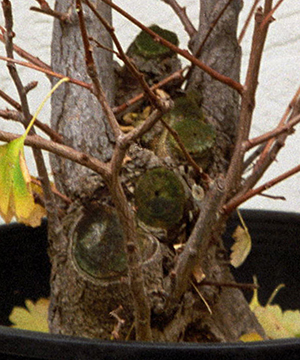
It went home with me lying on its side in the back of the truck--too tall to stand up and so heavy it took two people to load it in the truck. In late 1997, I took it to Ernie Kuo’s for help in design. After some discussion, we chose a front and I went to work. The top of the tree was reduced, crossing branches removed, the sides brought into proportion, and one small root cut off. The root looked dead; it was not and the entire area it supported was still live. The ginkgo proved to have a very diffuse water transportation system; so long as cuts were sealed, the sap would not withdraw and the underlying cambium would remain active. A good deal of carving took place to remove truly dead wood and to give a pleasing shape to the front of the left trunk. Carving on the right trunk and in the back would have to wait until the tree established a good set of new roots and could stand the cutting.
Some plants, like ginkgoes, are foolers; they look like their buds are going to open for a month before they actually open. Others, like elms, open so quickly that if you wait a day or two, it’s late and the leaves are already out. A few, like procumbens nana, can be transplanted almost any time in San Diego.
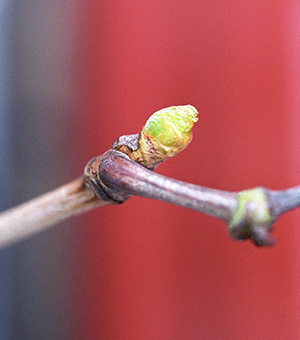
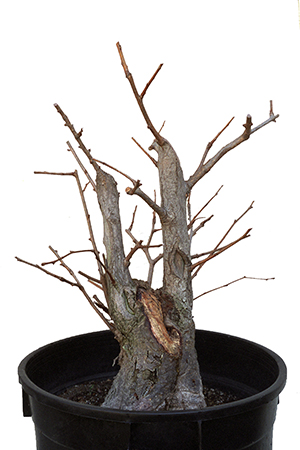
The best time to transplant is just when the buds are ready to open, not before and not later. March 11, 1998, Martha and I carried the Hashi ginkgo to the garage for transplanting. Mr. Hashi’s brother had done a good job; he had cut cleanly and potted well; many roots had developed on the tree, enough up high so that the major roots below could be shortened substantially. It went into a royal blue pot; deciduous trees can be potted in glazed, colored pots, and the light green leaf of the ginkgo would look good against the dark blue of the pot. The pot was about a $60 Japanese pot; I won it with $20 of raffle tickets. I had considered selling the pot, but now I’m glad I didn’t.
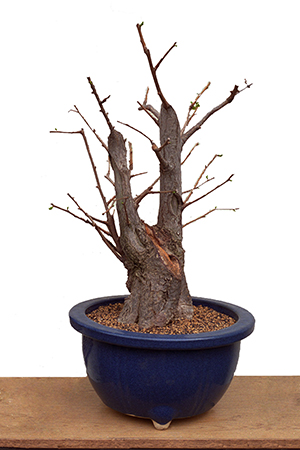
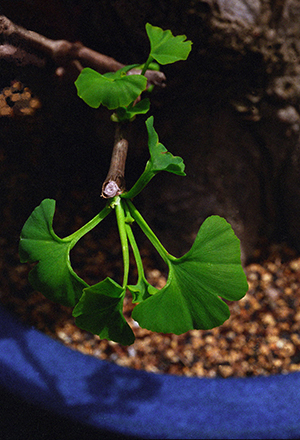
Ginkgo bonsai range from slim, pencil-thin individual specimens to large, old potted trees from trees grown in the ground and cut down to size. (Check the Internet. You will find some quick reading, some conflicting information, and three or four outstanding photos.) The small, slim trees also lend themselves to groves or group plantings. One type prized in Japan is called the chi-chi (breast or nipple) ginkgo because of the swellings and protrusions that form on the trunk. Leaf sizes vary and generally are reduced somewhat by potting. Healthy ginkgoes will have a blue-green leaf which turns to yellow before dropping in the fall.
Like Mr. Hashi, I reached an age where I knew I would not be able physically or artistically to develop the tree. I sold it to a younger person and have not seen it since then.
Small-leaved Gingko--The Internet articles do not mention a small-leaved cultivar. John Bleck, a Bonsai Club of Santa Barbara member, introduced me to Elbe Connors who had the first small-leaved gingko I ever saw. John and I watched him take cuttings and graft them. Many of these grafts were successful. I left wanting to own one of the small-leaved trees. Small-leaved plants are prized in bonsai. The Catlin elm, the Yatsubusa elm, and Little Lucy ficus as well as others have leaf sizes in proportion to their tiny trunks. Apparently the same biological mechanism that results in small leaves also slows the growth rate way down. I saw a gingko with similar small leaves in the ground in San Diego in front of a Chinese grocery store. Chinese consider the gingko to be lucky, but being in front of this store was not lucky for the gingko. I checked it again some years later and it apparently had died and been removed.
On January 24, 1999, I took cuttings from the two ginkgo trees in the restaurant parking lot. One showed some slight swelling of the buds; the other, the smaller-leaved, had some green showing which appeared to be small flowers opening.
Monday, the 25th, I took them to Los Angeles to Mas Ishii’s nursery, Chikugo-En. Mas grafted 30 cuttings onto under stock. A cut at a 45 degree angle shortened the under stock to about 1 inch above the rim of the pot. To use a top/side graft, 3 or 4 cuts were made on the opposite side of the angle to loosen the cambium for easy insertion of the scion, and the scion cut at a longer, more sloping angle than that used on juniper side grafts. The graft was then sealed.
I repotted the grafted ginkgoes in 3 inch pots, trimming the tap root off most of them, and put them in a worm-bin container with pumice covered with a layer of fir bark on the bottom, to hold moisture. The grafted cuttings proceeded to grow normal-size leaves. Either I underestimated the effect malnutrition has on plants or didn’t know the effect grafting might have on trees. We know the effect malnutrition has on people; it stunts their growth. The gingko from which I took cuttings was in a small opening in a concrete sidewalk and could have received only limited water from rain and no fertilizer from any source.
The under stock used in grafting can affect the scion. California is known for its oranges but it is not widely known that the flavor and other aspects of the fruit are determined in part by the under stock used for grafting. The people who grafted were so paranoid about identifying the under stock they used that they would lie and claim a different under stock had been used.
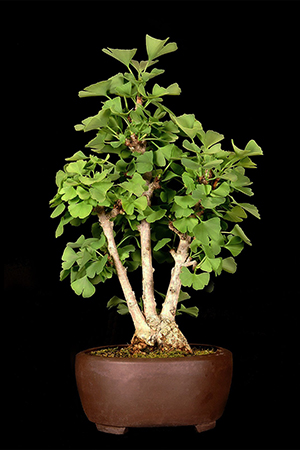
Photo by Leroy Kubel
Fifteen years later John was still doing bonsai. I called him about the small cultivar and got some interesting news. John had retired from his position as a Horticulturalist at the University of California Santa Barbara. Not only did he own a small-leaved gingko, he knew where there was one growing in the ground. The Club photographer would send a photo of John’s tree and John would photograph the tree in the ground and send that to me. As good as his word, here’s the photo of John’s tree. The style is a clump style and the height is 13 inches, measured from the lip of the pot to the apex of the bonsai.
Now you understand why I spent so much effort trying to obtain a small-leaved gingko.
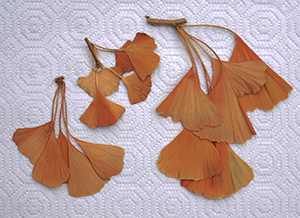
The three sets of leaves John mailed had been left on the ground with other leaves by the arborists who trimmed the mother tree. Excluding the stems, the small leaves are about 3/4” by 1 1/4” and the largest leaves are 2 1/8” by 2 1/4”. No way of telling whether they came from the same branch. John noted that some live branches had branchlets with nothing but small leaves on them (sports), raising the possibility that someone took a sport and developed a line of small-leaved cultivars. For some reason, the arborists chose to cut off all the low growth and down-hanging branches. This does show the mass of foliage compared to the small trunk and side branches, demonstrating again that the same mechanism that makes for small leaves slows all growth down.
The gingko grows in the U. S. as far north as the Great Lakes. It has been grown since ancient times around temples in China, where it is considered a sacred plant. It has existed essentially unchanged for millions of years, with fossil species occurring in the Triassic and Jurassic formations.
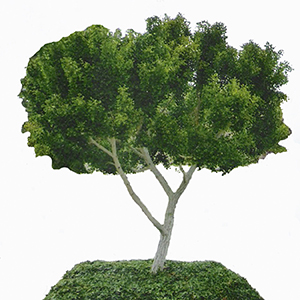
Photo by John Bleck
Here are some observations about growing gingkoes in San Diego’s sunny, hot, and dry climate:
Slow growers, even in the ground, where they may grow only 1 foot a year. Growth tends to be fairly straight and upright, with a few varieties showing a pyramidal form. Old ginkgoes may have a heavy trunk with smaller branches fanning out from the trunk.
Full sun when grown in the ground; in bonsai pots it may be best to keep the plant in full sun until leaves are fully developed and then move it to morning sun only. What appears to be a sunburned leaf may be the result of under fertilizing; if mature leaves are a light yellow, then move the plant to partial shade and fertilize properly.
Plants prefer a loose, well-drained soil, either in the ground or in pots. The San Diego basic soil mix (1 pumice: 1 #12 silica: 1 potting soil) works well.
Use more water rather than less; keep plants on the moist/wet side. Plants are resistant to oak root fungus so extra water is less of a problem than too little water.
Use mild fertilizer (cottonseed meal; fish emulsion, or similar low nitrogen products) on a regular basis. Stop fertilizing with nitrogen products in September and switch to a 0-10-10 formulation for light fall and winter fertilizing. The extra phosphate is useful even to non-flowering plants as it affects cell structure and the ability to balance liquids.
Prune branches only as much as is necessary to shape the tree. The wood is extremely soft until the tree ages; smaller branches have hollow centers; wounds do not heal over unless the cut is flush with the trunk and finished with a very sharp knife. Wounds are best if sealed to prevent withdrawal of the sap and subsequent rotting of the cut area.
Excess leaves should be removed; this helps keep leaf size small as the first leaves are smaller and later leaves are larger. Ginkgoes may be defoliated after the first set of leaves is complete; if you have not practiced defoliation before, start on one of your lesser trees until you are satisfied you know what will happen.
Do not wire, or else wire with extreme care. Wire marks never go away; instead, the distortion caused by wire increases in size over time. Small branches can be bent, but the clip-and-grow method is better. Use aluminum wire, if wiring must be done. Wire in early spring with new growth, watch daily for wire marks, and remove the wire as soon as possible.
Transplant just before buds burst. In the case of ginkgoes, this may be toward the end of March in San Diego; be careful not to be too hasty, as the buds are large and look as if they are going to open for almost a month. Roots are soft and fleshy and can be cut back moderately hard, even severely, if done with care. No sealer is required; the cuts callous over with a soft, fleshy callous. Transplant every other year, no more than every third year. Roots grow rather large and soil may be depleted by the increased watering given ginkgoes as compared to some other trees.
The male tree bears pollen; the female tree bears fruit with a very strong, disagreeable odor. Commercial nurseries graft from male trees or use cuttings rather than growing from seed. Although the plants will grow from seed, cuttings provide a larger plant quicker. Various techniques are used to get cuttings to root. One method calls for inverting the cutting, burying it in soil except for the base, letting a callous form on the base, and then re-planting the cutting right side up. Perhaps the most successful method in San Diego is sealing the top and bottom of the cutting immediately after the cuts are made and then planting it right away in a good rooting medium right side up. Occasionally air-layering will succeed, but in general the water transportation system of the plant does not respond well to the traditional ring-barking for air layering.
Generally no pests and diseases:
